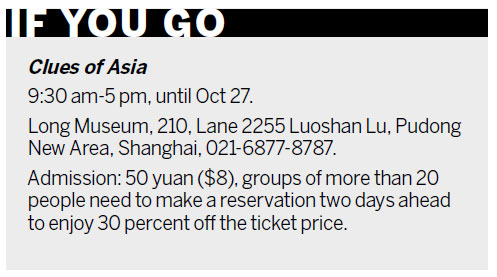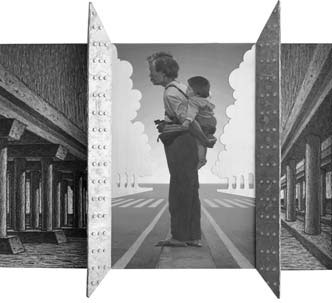Framing contemporary Asian art
Updated: 2013-09-22 07:58
By Zhang Kun in Shanghai(China Daily)
|
|||||||||
|
Sudden Comprehension is a synthetic-material painting by Lu Hsien-ming. Provided to China Daily |
Long Museum wants to draw public attention to Asia's contemporary art with its first international exhibition.
The private museum is hosting a show of 40 works from more than 30 Asian artists, named Clues of Asia - Asian Contemporary Art from Long Collection.
"For the past 30 years of China's cultural exchanges with other countries, America and Europe has been the axis," says curator Huang Du, a Beijing-based art critic. "Comparatively, we have not paid adequate attention to the relationship of China's art and culture with other Asian countries," he says.
Since the new millennium, the economic rise of the BRICS countries (Brazil, Russia, India, China and South Africa) has raised cultural development, too. Asian countries are gaining greater confidence in their own cultures, and more collectors are turning their eyes to Asia's own art. It's time the academics and public do the same, Du believes.
Long Museum is a private museum founded by Wang Wei and her husband Liu Yiqian. The museum has a quite smaller collection of contemporary Asian art beyond the Chinese mainland, in contrast to its extremely valuable collection of ancient Chinese art and extensive volume of modern and contemporary Chinese art.
"We have only about 100 pieces (from the area)," says the executive director of Long Museum, Huang Jian. "We hope this is the beginning of the Long Museum's international initiatives. From now on, we hope to present more artworks from the rest of the world."
It has been a great challenge for Du to sort through the limited collection of the museum's Asian art. Asia's culture, religion and geology are complex, he says.
Kwon Ki-soo, a 41-year-old artist from South Korea, attended the news conference before the opening. "In the past few years, the Asian economy has gone through some disturbance, making artists' lives unstable. Also, art institutions had little space for development," he says.
He is glad to see more private galleries and museums emerging in South Korea and other parts of Asia. "I am more motivated to create new works."
Although his work is sometimes categorized as "pop art", Kwon pointed out the problems with the popularity of "pop art" in South Korea. "Some young artists try too hard to please the public and produce works that are of little value," he says.
"It's important to make art approachable to the public, but it is not worth sacrificing the depth and breadth of art."
Each of the Asian countries has its distinctive cultural ecology, says Du, the curator. He has selected "star" artists, such as Japanese Kazuo Shiraga, Yayoi Kusama and Yoshitomo Nara, and young talent less familiar to audiences.
Japanese art is closely related to its modernization and popular manga culture. "Its most famous artists, Nara and Kusama, both show close ties to manga and animation," he says. "Instead of simple, happy aesthetics, their works reflect the solitude, depression and estrangement of modern living. They are rich and deep."
Kazuo Shiraga (1924-2008) is one of the earliest artists in the show. A pioneering avant-garde artist in Japan after World War II, he discarded the use of the palette knife and painted with his fully oil-stained feet with his body suspended from a rope. "The Guggenheim Museum did an exhibition of Shiraga recently. He is basically the starting point of contemporary art in Japan," Du says.
The artworks from Indonesia are obviously different from those of Northeast Asia, Du says. "Artists have used the international visual language to depict their distinctive position in the Asian landscape. Standing in front of the artwork, you can't help but think about the relationships behind each country."
Three permanent exhibitions are going on at the same time: Chinese Traditional Art from Long Collection, Revolutionary Art Since the Yan'an Era and New Art History from Long Collection (Modern Art).
zhangkun@chinadaily.com.cn

(China Daily 09/22/2013 page15)
